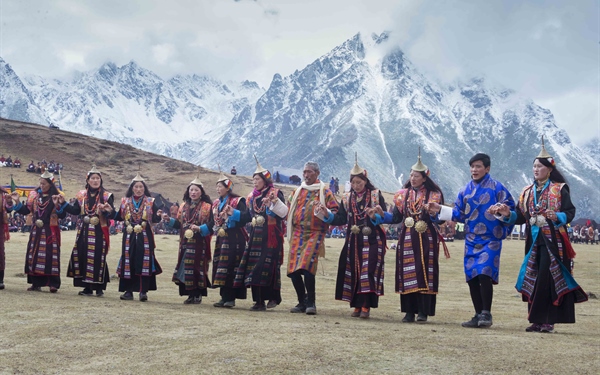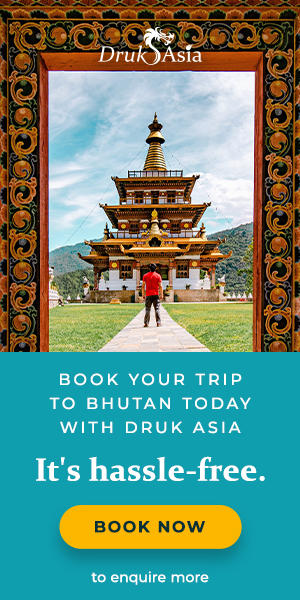Journey to the Fascinating Royal Highland Festival in Laya
Chimi Wangmo, based in Thimphu, traversed through beautiful landscapes to witness the fascinating Royal Highland Festival in Laya.
 Royal Highland Festival in Laya.
(Source: www.drukasia.com)
Royal Highland Festival in Laya.
(Source: www.drukasia.com)
Laya village, located on a flat surface amidst huge mountains at an altitude of 3,800m above sea level, is one of the most picturesque places in Bhutan. It presents every visitor with wondrous views of snow-capped mountains, alpine grasslands, unique customs and distinctive traditional costumes.
It takes two days to reach Laya from the capital city of Thimphu. I was there in October this year to witness the annual Royal Highland Festival, which is dedicated to the Highlanders in the country.
I started my journey on the morning of October 19. My backpack of clothes, blankets, trekking boots and other basic essentials weighed about 30kg.
Traveling in a bus with 25 people, the two-hour journey from Thimphu to Punakha ended when we finished introducing each other.
After an early lunch at Punakha, we proceeded to our first destination at Gasa, one of the remotest dzongkhag in the country.
Gasa is well known for its hot springs
Gasa is known for its hot spring and people in Bhutan travel to Gasa to soak in the hot springs, as it is believed that it could cure many diseases.
Almost after six hours of journey, soaking in the hot spring gave immense relaxation. People from all walks of life camped around the hot springs with their families.
Pema Lhamo, 48, from Trashigang, said her family brought her to the hot springs, as she was bedridden for almost four months. "I didn't know what I was suffering from. I couldn't walk properly because of giddiness and joints pain. I didn't have the appetite to eat anything."
She and her husband travelled for three days from her village in the eastern part of the country. "My health is improving," she said.
She said that they were in the hot spring for a stay of two weeks. After my conversation with the woman and a few other people, I had dinner and then I tucked into my warm sleeping bag.
We woke up at 4 am on the second day, as we were supposed to take a lift in a pickup bolero and reach Ponjothang, the end of the tarmac road and start our hike to Laya.
I had my breakfast and reached Gasa Dzong at 6 am where three boleros were parked. After some negotiation, the men decided to stay in the open cabin of the vehicle while the women stayed inside. After an hour and a half’s drive, the men and about 30 horses were waiting in Ponjothang to ferry our luggage.
The hike to Laya
The hike from Ponjothang to Laya is about 25 km, and the journey took approximately eight hours. We reached Laya when dusk enveloped the village. Everyone attended the festival were arranged at home stays and I stayed with a beautiful family, who provided us with warm food and a good place to sleep.
Layaps are rich people, as they make money by collecting cordyceps, a magical fungus which is believed to be boost immunity and is also an aphrodisiac. They stack the year's ration in the corners of the house and with many Chinese blankets to keep themselves warm.
We woke up on the third day to see snowcapped mountains surrounding the village. The local residents are strongly built. Most have red cheeks because of the cold weather.
The women draped themselves with woollen jacket and skirts with light rainbow strips. They also wear conical shaped bamboo hats with jewelry.
Layaps say that their nomadic life changed after the government legalised the collection of cordyceps, as a kilogram of good quality harvest can fetch up to Nu 1.2M, the equivalent of USD 18,500.
The Royal Highland Festival in Laya
I stayed in Laya for five days, attending festivals where highlanders showcased their talents as well as their cattles and horses. There were also many functions meant to entertain guests, such as indigenous songs and dances.
More than 3,000 people gathered in the village during the festival. The villagers said that the place is otherwise desolate, as only the aged and children stay in the village. In the summer, people move to the mountains to collect cordyceps and for grazing pastures. In the winter, they move to the warmer places.
We returned to the hot spring on the eight-day and to Thimphu the next day. The Royal Highland Festival brought together people from diverse professional background together. I also made many friends from the locality. It was indeed an enriching cultural experience!
By Chimi Wangmo for Daily Bhutan.
Book your trip to attend the Royal Laya Highland Festival now!




